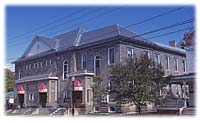Return to Gwyneth Walker Music Catalog
Download an a MP3 file of the first movement of this work performed by University of Lousiana at Monroe Faculty Brass Quintet.
Download an a MP3 file of the second movement of this work.
Download an a MP3 file of the third movement of this work.
Download an a MP3 file of the fourth movement of this work.
(Photograph of Chandler Hall, Randolph, Vermont.)

Composed in celebration of the Centennial of Chandler Music Hall, Randolph, Vermont: 1907-2007
The concept behind the creation of this set of pieces for brass quintet was to join together the past and present through music. In celebration of the Centennial of Chandler Hall, it seemed appropriate to select songs which were popular at the turn of the 19th-20th centuries - songs which Albert B. Chandler and the residents of Randolph, Vermont might have been enjoying at the time of building Chandler Music Hall - and to "revisit" these songs with new explorations.
The brass quintet and brass band genres were very popular a century ago. So, in composing music for brass, perhaps to be performed in the gazebo in the village center, it is envisioned that joyous elements from the past might be brought back to life again.
The set opens with "Ta-Ra-Ra-Boom-Der-E," a flirtatious and popular song heard in music halls at the turn of the century. This new arrangement for brass features a triumphant introduction which recurs throughout the movement, introducing each verse and refrain. The first verse is presented in a relatively straightforward manner by the trombone and horn (with commentary from the other players). The second verse dwells upon the "dainty" character of the female singer. Mutes are a featured part of this section. The final refrain is especially exuberant, with rapidly ascending scales and glissandi in abundance.
"The Man on the Flying Trapeze" is portrayed as a swaying waltz, as though swinging on a trapeze. The theme is mostly presented in the trombone and horn, while the trumpets provide a "high-flying" filigree counterpoint. [The tuba, not to be forgotten (!), has its own interlude.] Up and down, back and forth, the motion of the trapeze inspires the music throughout.
Mournful, blues sonorities are heard in "Bill Bailey..." in keeping with the song lyrics: "Won't you come home, Bill Bailey, won't you come home?" she moans the whole day long. The slow introduction in the key of E flat minor soon yields to an up-tempo presentation of the theme in E flat major. But the minor modality (the mournfulness) returns in trumpet phrases floating above the ensemble. This mixture of major and minor recurs throughout the song, including the final mixed-mode chord.
A medley of opposites concludes the set. "In the Good Old Summertime" is a lazy waltz. The melody is heard first in the trumpet, with simple accompaniment beneath. An interlude with delicate scale patterns is inserted, leading back to the peaceful melody in the trumpet. Then, the tranquility is brusquely interrupted by the boisterous arrival of "Good Night, Ladies!" This might be a way of saying "the leisure of summertime has now ended," or, "the party is over!" The two melodies alternate one more time, with the boisterous sounds ending the suite.
The Flying Trapeze was composed during the Fall of 2005, as a gift from the composer to her adopted home community of Braintree and Randolph, Vermont. The Chandler Music Hall and Cultural Foundation have been very supportive of the musical career of this local composer. The creation of this brass suite is one way of returning the favor!
Notes by the composer